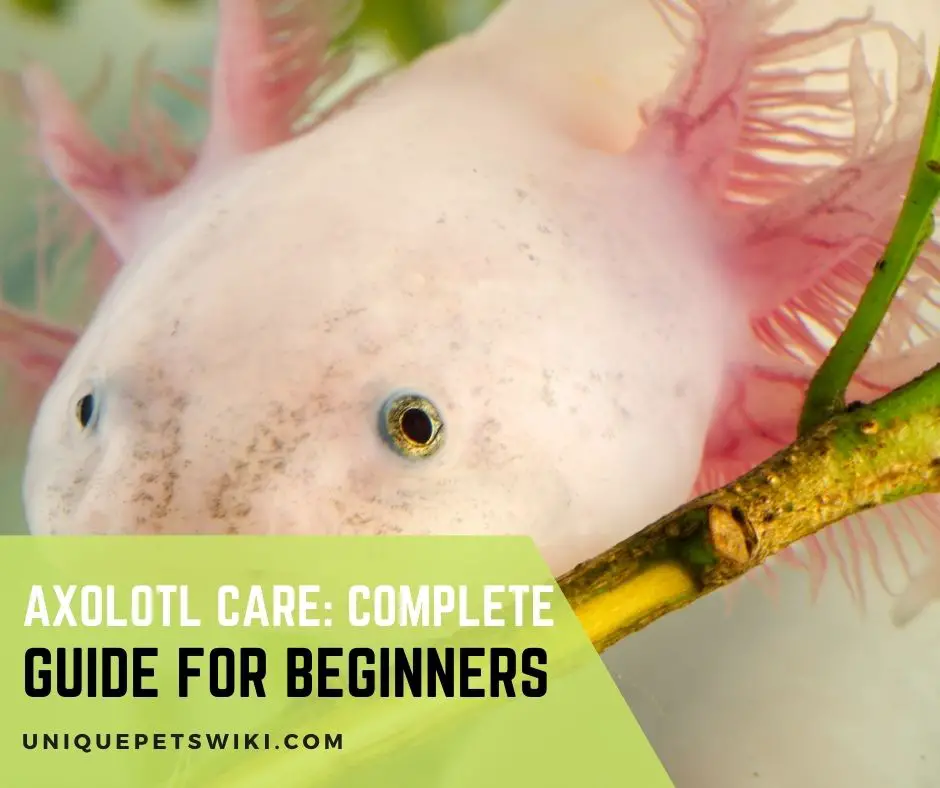Axolotls, also called Mexican walking fish, are unique salamander species from a small region in eastern Mexico.
They have cute faces with fascinating personalities and might be exactly what you need. However, you may be wondering if they are suitable for beginners and easy to care for.
Although axolotls require special care to live healthy and happy, it is not that hard to care for them.
Axolotls prefer a cool water tank with low lighting to stay active, and they also require specific water parameters to stay healthy.
This guide will give you an insight into what axolotls require, the ideal enclosures they need, and the best way to care for them as a beginner.
Contents
Axolotl Care: Complete Guide for Beginners
Generally, axolotls are not an ideal pet for beginner pet owners with no experience in caring for amphibians. This is because you cannot handle or remove them from the water.
Furthermore, they have extremely sensitive skin, and you need to keep an eye on their water quality from time to time when caring for them.
They require at least a 20 gallons tank with a lid and cold water to stay happy and healthy.
Setting up an axolotl tank will depend on your budget, but you need to ensure you add a filter and cycle their tank before introducing your axolotl.
However, caring for axolotl is not that difficult, even for beginners as long as you spend some time learning.
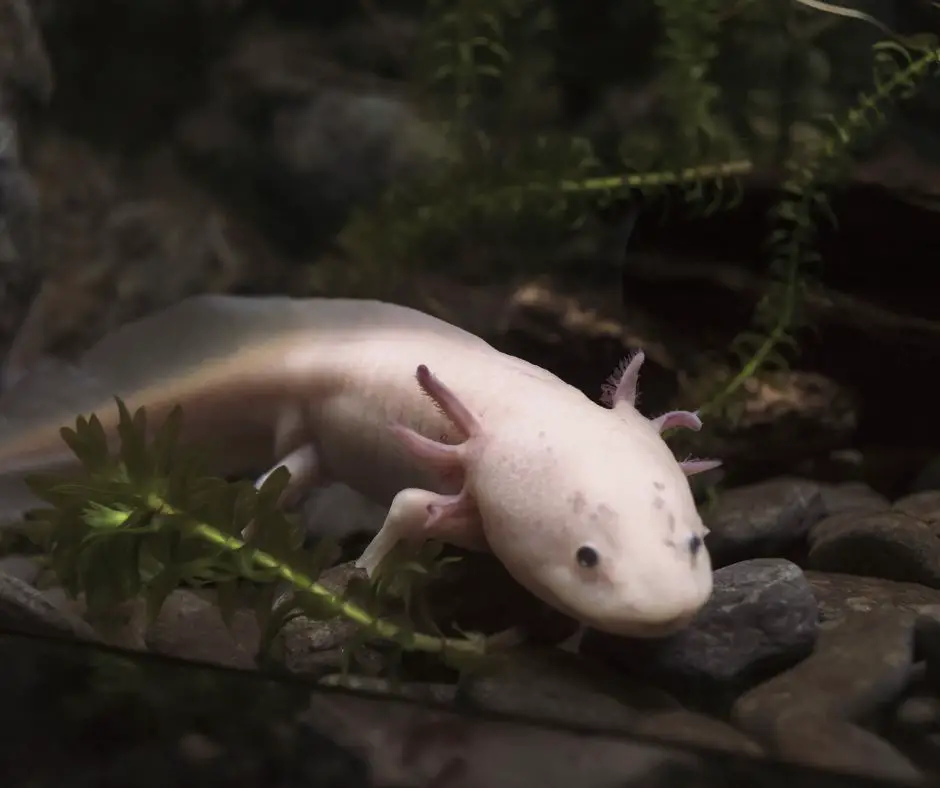
Axolotl Housing
The size and number of axolotls you plan to care for will determine the type of tank you can use.
The minimum tank size for axolotl is 10 gallons. However, it is recommended that you house an axolotl in at least a 20-gallon long tank to help give it enough space to move around.
You can then add 10 gallons whenever you plan to add a new axolotl to the tank.
Another thing is that axolotls produce lots of waste, and housing them in a tank with enough space helps ensure the ammonia and nitrate levels don’t get out of control quickly.
When it comes to axolotl housing, the tank floor space is more important than the height, and this is because axolotls are bottom dwellers and will need lots of space to move around.
There are several tank décors that you can add to your axolotl’s tank to help make the tank comfortable for them.
The best substrate for your axolotl tank is fine sand. This will help give your axolotl more grip when walking around the tank.
The best thing is that fine sands cannot cause impaction if your axolotl mistakenly ingested them.
Another thing is that axolotls do not require heaters in their tank because they need cold water. Instead, you can add a chiller or cooler to their tank if you live in a hot area.
Axolotls are quite sensitive to light, and you don’t need to add light to their tank.
Furthermore, you will need to include at least 2 hides where your axolotls can hide. You can buy axolotl hides online or from local pet stores or use DIY hides. Some of the other accessories that you may need are filters, air stones, plants, etc.
PRO TIP
What to avoid:
- Avoid using sharp accessories in your axolotl’s tank because axolotl has fragile skin.
- Avoid using gravel as it can cause impaction.
- Avoid placing your axolotl tank in direct sunlight as axolotls are sensitive to bright lighting. Furthermore, placing an axolotl tank under direct sunlight can warm the water in the tank.
- You don’t need to add any special lighting because axolotls are sensitive to bright lights.
- Avoid housing your axolotl in a tank with a strong water current, which can stress them out.
Feeding Your Axolotl
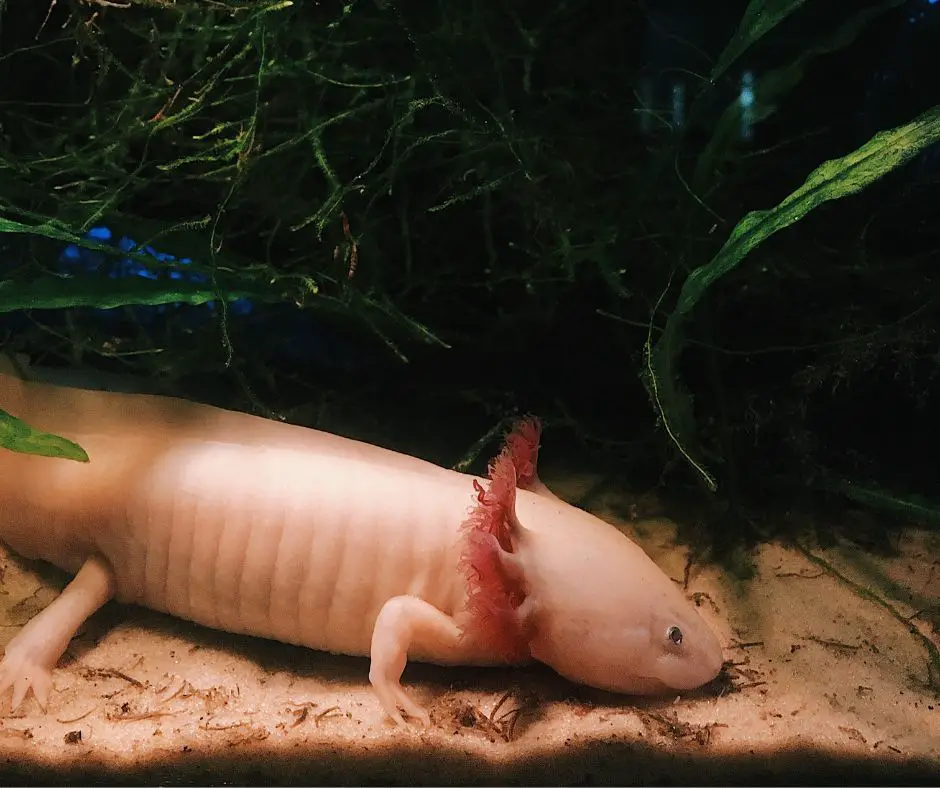
Axolotls are not picky eaters, and you can feed your axolotls with live nightcrawlers, red wigglers, bloodworms, Mysis shrimp, small fish, pellets, and small bits of raw, lean beef heart.
Axolotls prefer live food, and they hunt by opening their mouth to suck prey.
You can feed adult axolotls 2-3 medium-sized nightcrawlers or one teaspoon of bloodworms every other day. However, you will need to feed a baby and grow axolotls with 4 small worms every day.
Generally, axolotls usually stop eating once they are full. You can try to increase or decrease the amount of food you feed them until they are full.
You can feed your axolotl any time of the day. There are times that axolotls lose interest in eating during the day, and you can then feed them at night to restore their appetite. As stated before, axolotls prefer live food.
This is because they don’t see very well, and they use the movement of their prey to locate them.
On the other hand, you will need to hand feed your axolotl with a long tong or tweezers when feeding them with dead prey or pellets to help entice your axolotls to eat them.
Furthermore, many axolotl owners recommend this method as it helps to reduce the amount of uneaten food and waste in your axolotl’s tank.
A healthy axolotl can survive without food for about 3 weeks or 4 weeks. However, an unhealthy axolotl can only survive for about 2 weeks.
Don’t forget, you will need to remove uneaten food from the tank to help ensure you don’t dirty the water.
2-Pack 15 inch Heavy Duty Stainless Steel Long Tweezers
- Medical Grade Stainless Steel Material construction with a anti-slip tips for optimal angle. No Colored & Chemical Free
- Multi-function 15 inch Long - 1) Aquascape tool for aquarium fish tank can easily grasp leaves and snails when maintenance plants. 2) Safe feeding forcep for reptiles, such as chameleon, snake, frog, bearded dragon, gecko, tortoise, iguana, lizard, tarantula etc.
- Curved & Straight Tweezers - Dynamics concerned design with excellent flexibility, specially designed delicate clip end easy to pick up small object.
- Easy Handling Big Size - Comparing with other tweezers, our products are more durable, good grip, rust-free and anti-slip. Easy Handling big size. Each tweezers length: 15" . Perennial tweezers
- Our products have been inspected by a reputable third party inspection company. Each product has been checked. Don't forget to buy this as a PERFECT GIFT for your family & friends.
Last update on 2022-12-30 / Affiliate links / Images from Amazon Product Advertising API
Cleaning Axolotl Tank
One of the important things when it comes to axolotl care is tank maintenance. There are several things that will decide how often you will need to clean your axolotl’s tank, they are:
- The enclosure size.
- The number of axolotls in the tank
- The filtration system being used, etc.
Axolotls usually produce lots of waste and can easily affect the water quality in their tank.
Therefore, it is important that you remove leftover food and axolotl’s poop to help reduce the risk of chemical buildup in the tank. Furthermore, you should clean axolotl waste once you notice it in your axolotl’s tank.
How To Clean Uneaten Food And Poop From Axolotl’s Tank.
You can clean axolotl poop and uneaten food from the tank using a gravel vacuum cleaner or turkey baster to siphon them out. Here are steps you can follow when using a turkey baster to clean out axolotl’s waste.
- Squeeze the air out of the turkey baster’s bulb before putting it in the water.
- Gently put the end of the baster down into the tank where the waste is located.
- Ease the pressure off the bulk to siphon the waste into the baster.
- Remove the baster after siphoning out the waste.
- Empty the waste into a bowl and dispose of it.
Steps To Follow When Cleaning Axolotl’s Tank
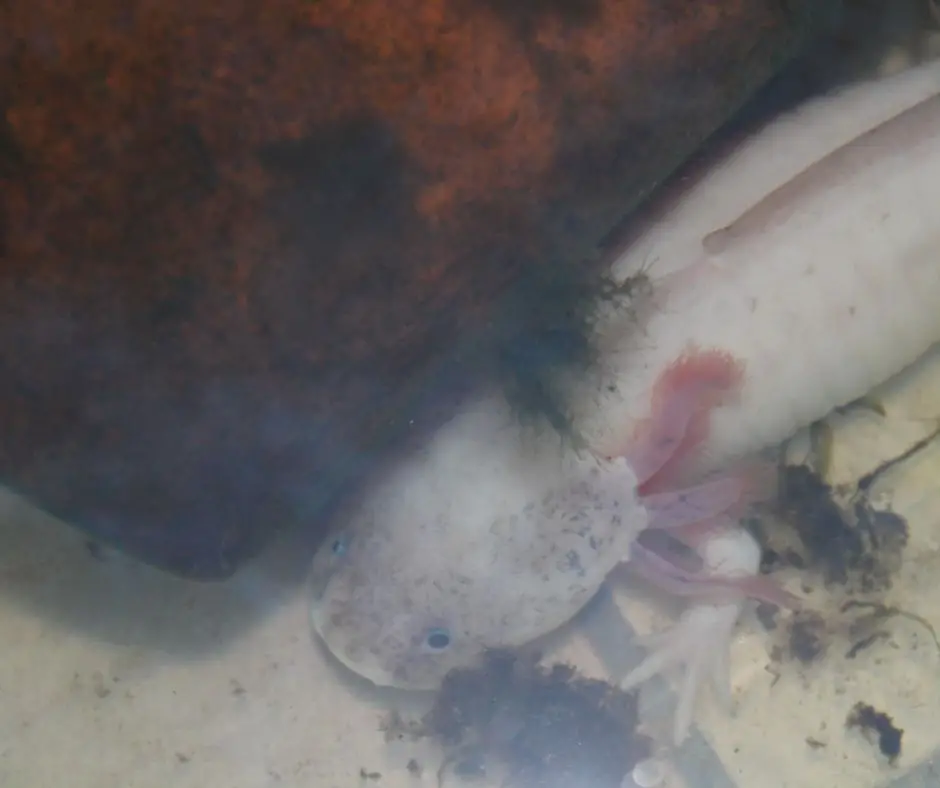
Here are steps that you can follow when cleaning your axolotl’s tank
- Prepare the water you want to use to replace the water you remove from the tank.
- Remove 20% of the water in the tank.
- Siphon out the debris, leftover food, and poop from the tank using a gravel cleaner or turkey baster (this step can be done once a week or every other week, even when you are not cleaning the tank).
- Remove the tank decorations and toys and clean them thoroughly with a brush or sponge. Ensure you rinse them with clean and fresh water without any detergents before adding them back to the tank.
- Refill the tank with the prepared water.
Note: you will need to clean your aquarium filter once a month. It is recommended that you clean them at least a week after cleaning the tank to help ensure your pet is adjusted to their new conditions.
Maintaining a Tank
Axolotls spend their lifetime in water and need water for nutrition, excretion, respiration, etc.
This indicates that the type of water you use for your axolotl tank will affect its overall health. Axolotls require brackish water but can adapt to freshwater.
Water
The ideal water for axolotl’s tank is tap water and bottled water. Most bottled waters are treated spring water rich in natural minerals and salts, making them safe for axolotls.
However, it is quite expensive to use them for your axolotl’s tank.
Most tap waters are usually treated with chlorine and chloramines, making them bad for your axolotls.
However, they are quite cheap. Therefore, you will need first to prepare tap water with a water conditioner to remove the chlorine and chloramines before adding them to your tank.
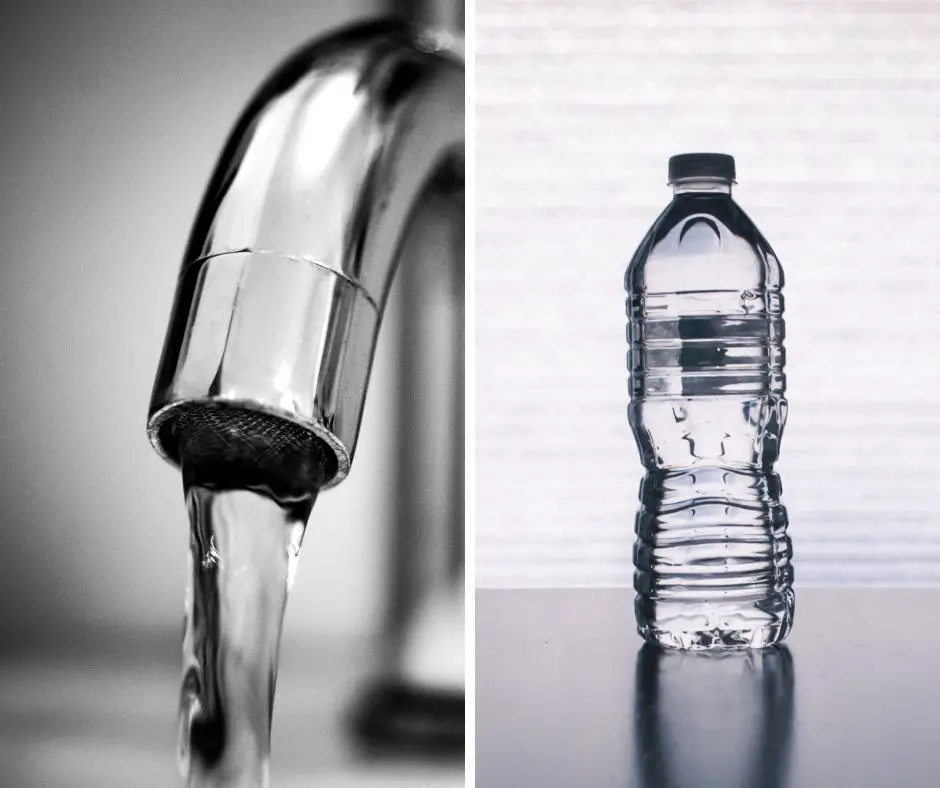
You should avoid using well and distilled water for axolotl’s tank. This is because most well waters have high iron content or pH not suitable for axolotls.
Furthermore, distilled water does not have the minerals and salts your axolotl needs.
Axolotls require a specific water condition to keep them happy and healthy. The breakdown of the ideal water conditions for axolotl is stated below:
- Acceptable and Ideal pH Levels: 6.5-8.0 and 7.4-7.6, respectively.
- Nitrate: less than 40ppm.
- Nitrites: 0ppm
- Ammonia: 0ppm
- KH: 3-8deg (53-143ppm).
- GH: 7-14deg (125-250ppm)
- Oxygen: 70 – 100%
- Temperature: 16-18oC or 60-64oF.
It is important that you change 20% of the water in your axolotl’s tank once a week if you have a filter. However, you will need to change 20% water once a day if you are not using a filtration system.
API FRESHWATER MASTER TEST KIT 800-Test
- Contains one (1) API FRESHWATER MASTER TEST KIT 800-Test Freshwater Aquarium Water Master Test Kit, including 7 bottles of testing solutions, 1 color card and 4 glass tubes with cap
- Helps monitor water quality and prevent invisible water problems that can be harmful to fish and cause fish loss
- Accurately monitors 5 most vital water parameters levels in freshwater aquariums: pH, high range pH, ammonia, nitrite, nitrate
- Designed for use in freshwater aquariums only
- Use for weekly monitoring and when water or fish problems appear
Last update on 2022-12-30 / Affiliate links / Images from Amazon Product Advertising API
Substrates
As stated before, putting substrate in axolotl’s tank helps give axolotl a grip when walking in their tank. The good thing about axolotl’s substrates is that you don’t need to change them often.
You can easily go for a year without changing the substrate if you maintain the tank very well.
Keeping A Clean Axolotl Tank:
Although axolotls require specific water parameters to stay healthy, they usually produce lots of waste. Here are some tips that you can follow to keep your axolotl’s tank clean.
Do Not Skip The Nitrogen Cycle
Cycling your tank is an important aspect when preparing your axolotl’s tank. This is because it will help create beneficial bacteria in the tank to remove toxic chemicals from your tank.
Therefore, you should not skip this process if you want your axolotl tank to be clean.
Get A Filter
A filter is an important accessory for an axolotl tank when caring for axolotl because it helps to remove harmful chemicals from the tank.
Therefore, investing in a filter is a great way to keep your axolotl’s tank clean, and it will even reduce how often you need to change the water.
Stir Substrates Before Adding Them
A helpful tip to keep your axolotl’s tank clean is to stir the substrates before adding them to your axolotl’s tank and even during a water change.
This will help keep the sand clean on the surface and make siphoning out of junk in the substrates possible.
Spot Clean The Tank Regularly
It is recommended that you regularly spot clean your axolotl’s tank if you want them to stay clean. The buildup of waste and uneaten food can lead to bad water quality.
However, regular spot cleaning of the uneaten food and waste from the tank can help make the tank stay clean.
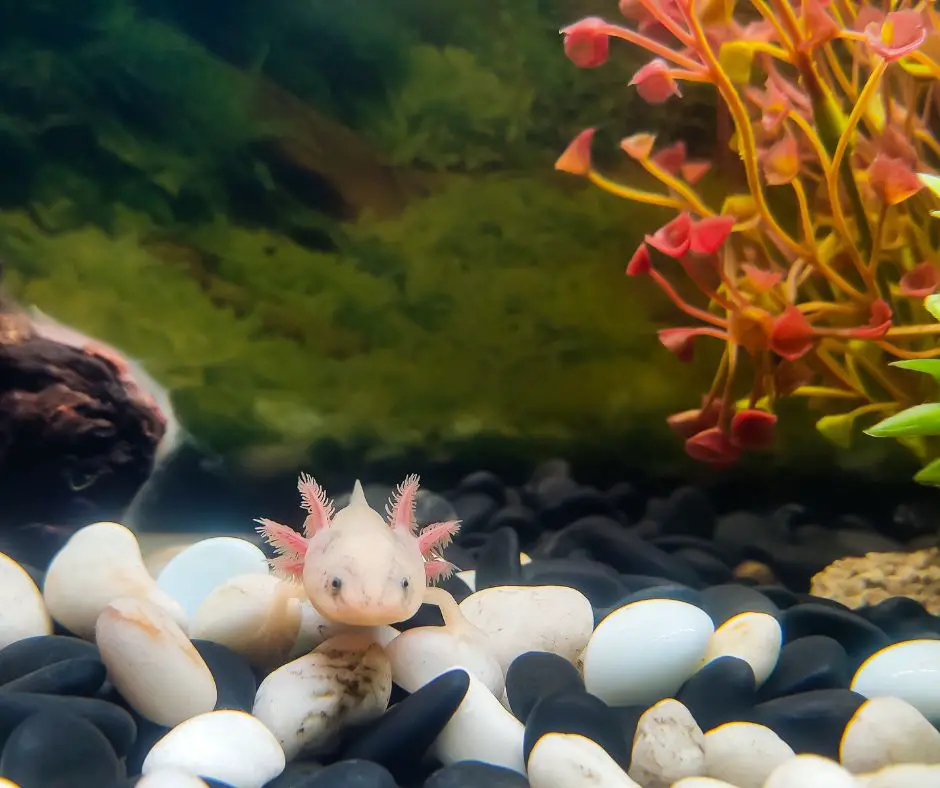
Behaviors & Temperaments
It is important to understand your axolotl’s behavior to help determine when they are happy or stressed.
Axolotls are slow-moving amphibians and are usually active at night. They also spend most of their time walking at the tank bottom.
Axolotls prefer to live a sedentary lifestyle and usually move around during feeding. You can also see your axolotls digging and rearranging their tank décor if you have sands and décor in their tank.
Another thing is that axolotls are shy and love hiding, but they can be trained to associate with their owner.
It is quite easy to keep axolotl happy by feeding them a nutritious diet, and you keep them in an ideal environment. However, some of the signs to determine that axolotls are happy are:
- A young axolotl may show that it is happy by climbing plants, hiding in the hideouts, or swimming around the tank frequently.
- A happy axolotl can play with the bubbles if you have a bubbler
- A happy axolotl skin looks healthy
- A healthy older axolotl shows more movement when feeding.
Although axolotls always have a smile on their face, this does not mean they are happy. Axolotls can easily get stressed even with a slight change in their ideal environment.
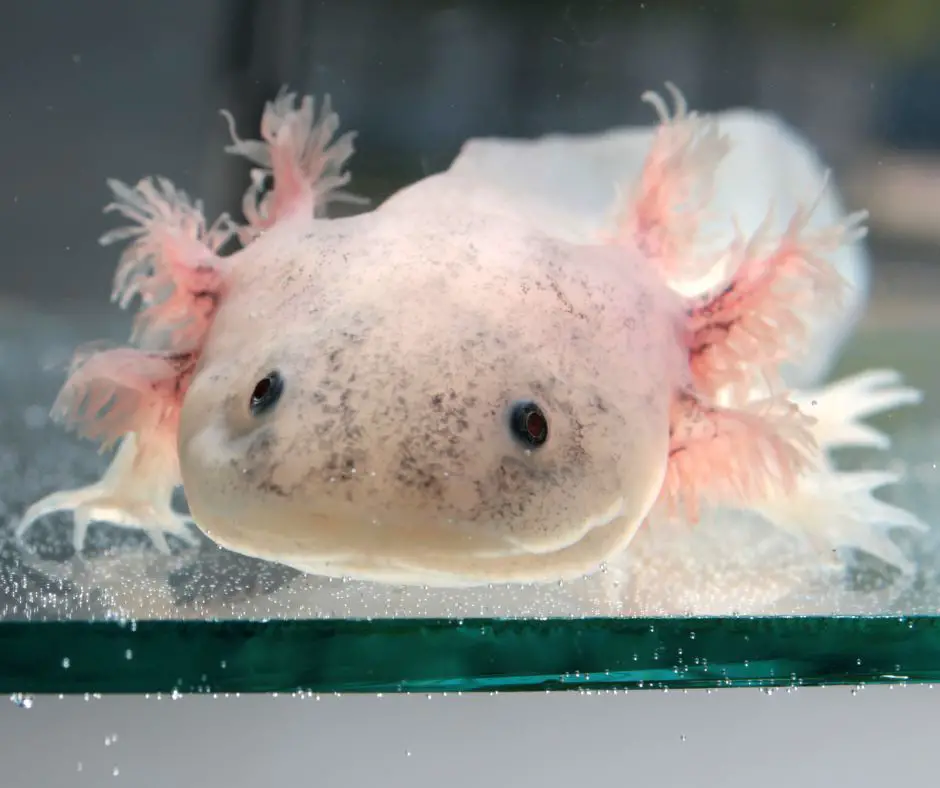
Some of the signs that indicate that an axolotl is stressed are:
- Their gills curl forward
- not eating or lost its appetite
- Lack of response from your axolotl.
- frequently goes up for air.
- throws up its food.
- curled round tail tip.
- Loss of pigment
- floating frequently
- Your axolotl swims frantically.
Handling Your Axolotl
The axolotl is not suitable for you if you are looking for a pet that you can handle. Although axolotls can breathe outside the water, they spend their lifetime in the water.
Furthermore, they have delicate skin covered with a protective mucus layer. Handling them can cause the mucus layer to rub off, making them vulnerable to skin infections.
It is recommended that you transfer them to a separate container with a soft aquarium net whenever you are moving them from one tank to another.
However, axolotls are curious creatures and can even recognize their owners. You can even see your axolotl swim to the tank side when they notice movement around their tank.
Breeding
Breeding axolotls in captivity is quite straightforward. However, you should not attempt to breed your axolotl unless you have a few years’ experience caring for them.
Axolotls are prolific breeders and can breed all year round under optimal conditions.
Axolotls usually reach sexual maturity between 5 months to a few years based on their environment and food quality. However, it is recommended to breed your axolotl only when they are at least 18 months old.
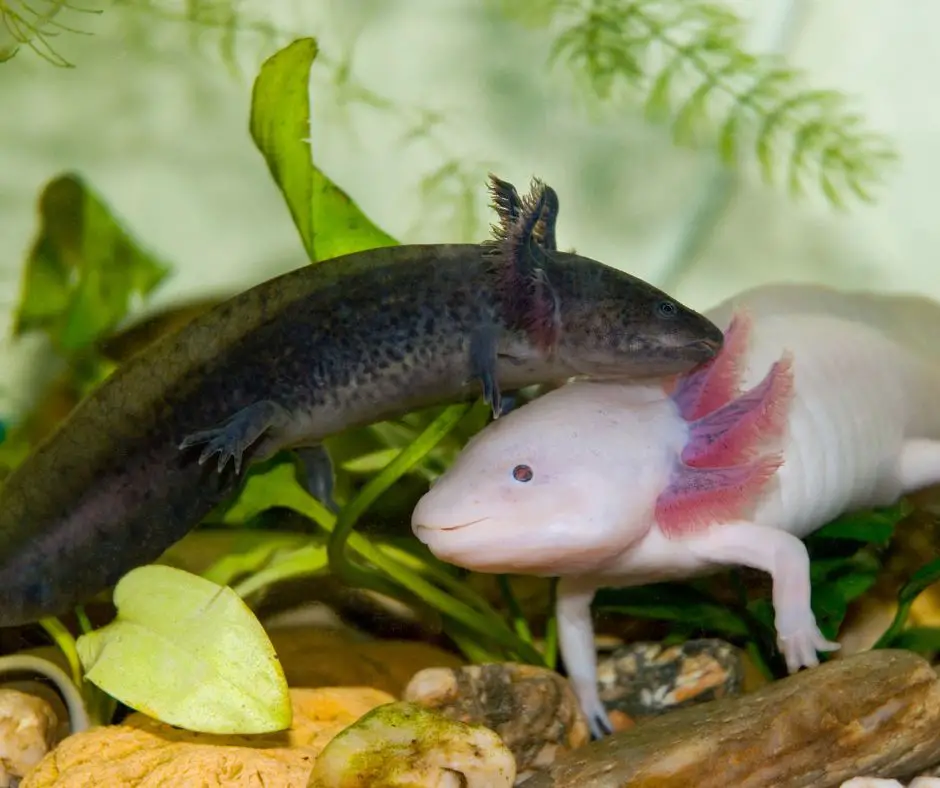
Some of the steps that you can follow when breeding axolotls are stated below:
- Introduce the male to the female (the male will poke the female with the snout if interested in breeding but can show aggressive behavior towards each other if they are not interested. You will then need to separate the pair)
- If interested, the pair will then mate and the male will leave will leave the sperm on the substrate and accessories while the female collects the sperm by rubbing against it.
- You can then separate the female from the male to prevent cannibalism.
- The female axolotl will then lay the eggs about a day later
- You can separate the eggs from their parents.
- The eggs will then hatch into larvae in about 3 weeks based on the temperature.
Check out our article on how to breed and care for axolotl during this period.
Common Health In Axolotls
Although axolotls are hardy, they can experience health problems. The main cause of health problems in axolotls is poor water conditions.
Your axolotl will become lethargic and lose their appetite once they are sick. You can also notice sores and irritation on your axolotl’s skin.
Some of the common axolotl problems are
- Injury
- Impaction
- Fungal infections
- Red flags.
The main cause of fungal infections and red flags in axolotl is poor water quality and chronic stress. Impaction in axolotl usually occurs if your axolotl eats foods or accessories that block their digestive system.
Injuries in axolotls can occur due to aggressive tank mates, sharp accessories, etc. The injuries can then become infected if not treated accordingly.
However, the good thing is that you can prevent health issues in axolotls by monitoring their water parameters regularly and avoiding stress-inducing factors.
4 Best Common Treatments For A Sick Axolotl
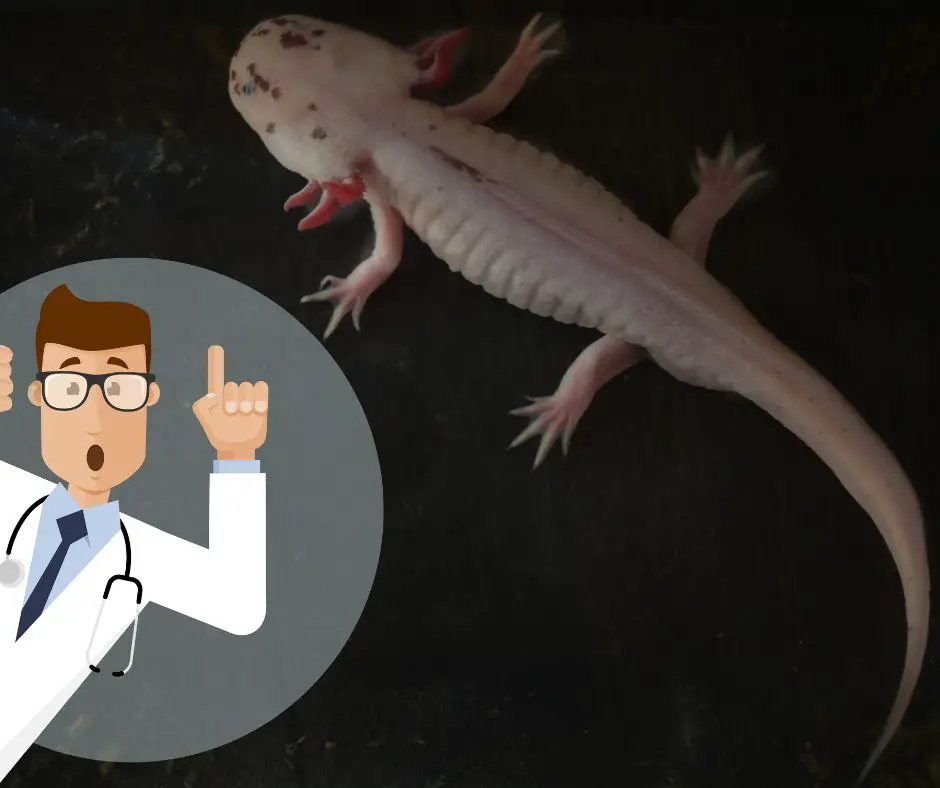
Caring for axolotls becomes easier if you understand the treatment options. There is four common treatment options for a sick axolotl, and they are stated below:
- Tea baths
- Refrigeration
- Salt baths
- Improving water quality.
Tea Bath
A tea bath is a great treatment option for axolotl with a skin condition. Tea baths aid in repairing minor skin issues, keep slime coat from peeling off and shield axolotl’s skin from fungus, bacteria, and toxic chemicals.
Here are steps that you can follow when giving your axolotl a tea bath:
- Separate the sick axolotl from the healthy ones to reduce infection risks.
- Prepare the tea bath solution by brewing the tea for 10-15 minutes by dropping the black tea bag in the water and leaving it for 10-15 minutes.
- Pour the brewed tea into a container where you want to give your axolotl a tea bath.
- Allow the water to cool to room temperature before adding your axolotl to prevent heat shock.
- Use a soft net to move your axolotl from the quarantine tub to the tea bath solution.
- Leave your axolotl for about 10 minutes in the tea bath before transferring it back into a container with clean dechlorinated water.
- Try the step above daily until your axolotls have recovered completely.
- Return your axolotl into their tank.
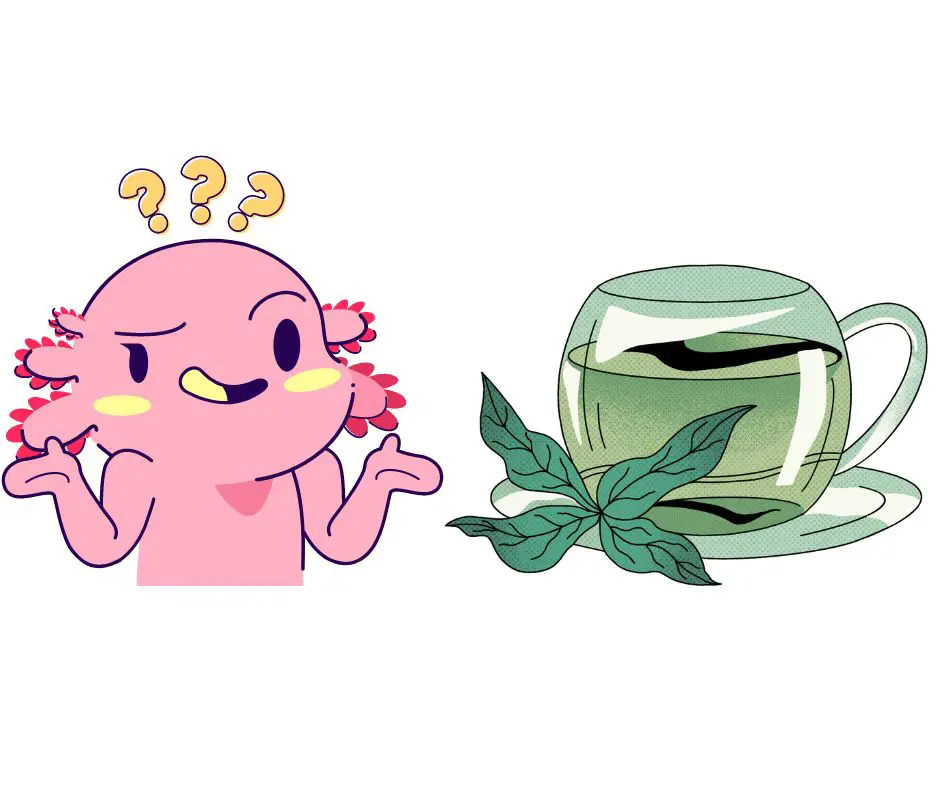
Note
You should not be alarmed if your axolotl makes faces that suggest they are about to vomit during the tea bath. This shows your axolotl does not enjoy the bath, but you should ensure you don’t leave them for over 10 minutes in the tea bath.
Salt Bath
A salt bath is a great way to treat axolotls suffering from skin and fungal infections. The salt helps to kill off the infection, and it is most effective if you use this method with fridging. Here are steps that you can follow when giving your axolotl a salt bath.
- Mix dechlorinated water with aquarium salt, rock salt, or sea salt.
- Refrigerate the dechlorinated water to 5-8C.
- Once cooled, remove the container from the refrigerator and shake it.
- Fill the bathtub where you want to give your axolotl the bath.
- Add your axolotl to the tub with a soft net.
- Leave your axolotl for about 10-15 minutes.
- Remove your axolotl from the tub.
- Repeat this process every 12 hours until the infection is clear. You can also continue this process for 2-3 days to ensure the remaining fungus are dead.
Note: Avoid using table salt for this process.
API Aquarium Salt
- Contains one (1) API AQUARIUM SALT Freshwater Aquarium Salt 65-Ounce Box
- Promotes fish health and disease recovery with increased electrolytes
- Improves respiration for fish in freshwater aquariums
- Made from evaporated sea water for all-natural results
- Use when changing water, when setting up a new freshwater aquarium and when treating fish disease
Last update on 2022-12-29 / Affiliate links / Images from Amazon Product Advertising API
Fridge
Axolotls prefer cold water and a great way to treat disease or slow down a disease is to lower their water temperature. Fridge can also be used to treat impaction in axolotl.
Some of the health problems that you can treat with fridging are
- Axolotl suffering from mild infections
- Axolotl suffering from physical damage and stress caused by poor water quality.
- The axolotl is constipated or impacted
- The axolotl is going downhill quickly.
- Axolotl is in a critical condition.
Some of the benefits of fridging axolotls are
- Fridging helps to slow down the growth of pathogens like bacteria, viruses, and fungi.
- Fridging allows the immune system of your axolotl to work efficiently.
- It allows medication to work
- It helps axolotl owners to determine the underlying cause of an illness.
- It can work as an appetite suppressant
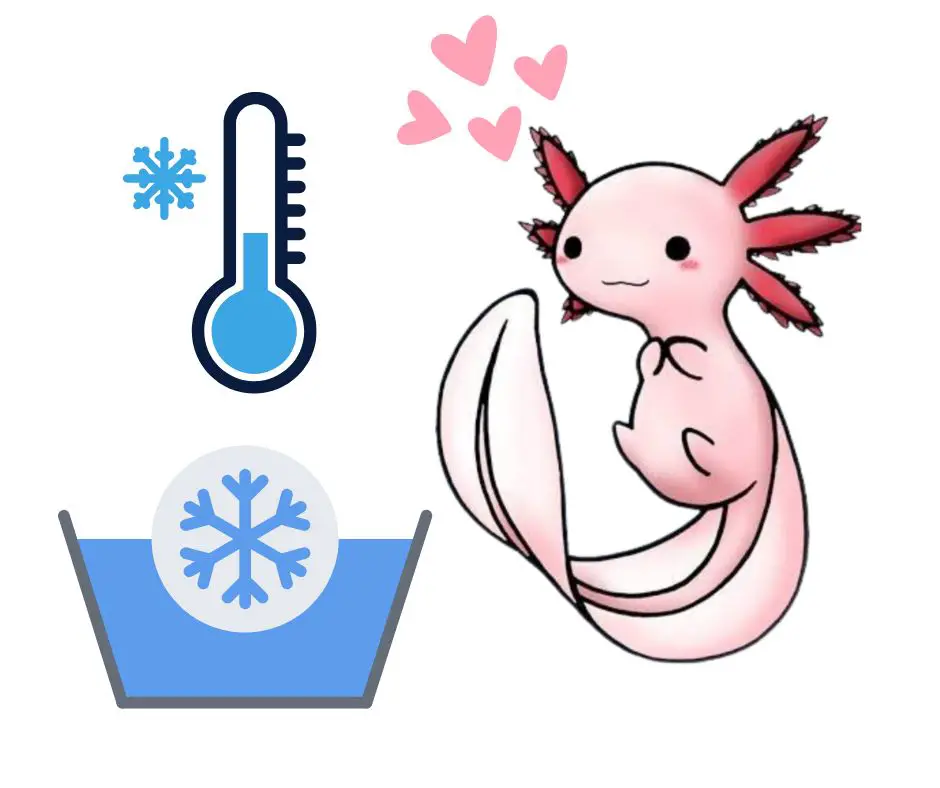
Note
Fridging is not a treatment for all health problems in axolotls and you should avoid using it for all axolotl sickness.
It is recommended that you should only use it as a last resort when other treatment fails. This is because refrigeration can add to your axolotl’s stress if it is not done properly.
You can read more on how to refrigerate your axolotl here.
Improve Water Quality
Water quality is very important for an axolotl’s tank, and you can easily prevent and treat lots of health conditions by improving the water quality in their tank. Some of the ways that you can improve the water quality in an axolotl’s tank are:
- Change your axolotl’s water regularly
- Add live plants into your axolotl’s tank.
- Test the water quality in your axolotl’s tank with a water testing kit.
- Remove uneaten food and waste from your axolotl’s tank regularly.
5 Common Problems When Caring Axolotl
There are several problems that you can experience when caring for an axolotl’s tank. Some of them are stated below:
Jumped Out Of Tank
Axolotls can jump out of their tank if you don’t put a hood or lid on their tank. Jumping out of the tank can be fatal if you find your axolotl late and they have dried out. Some of the reasons why axolotl can jump out of the tank are:
- Your axolotl is curious and trying to explore areas out of the tank.
- Poor water quality
- The tank is too small
- Stress
- Your axolotl is undergoing metamorphosis.
If you find your axolotl out of the water, the first thing to do is put it back into the tank. You can then check for signs of injury and whether your axolotl is eating.
Your axolotl is lucky if it goes back to its normal routine after jumping out of the water.
However, you may need to consult with your vet for help if your axolotl is not eating and looks injured. The best way to prevent your axolotl from jumping out of the tank is to use an aquarium hood or lid.
You will also need to regularly check the water parameters to help ensure the water is conducive to your axolotl.
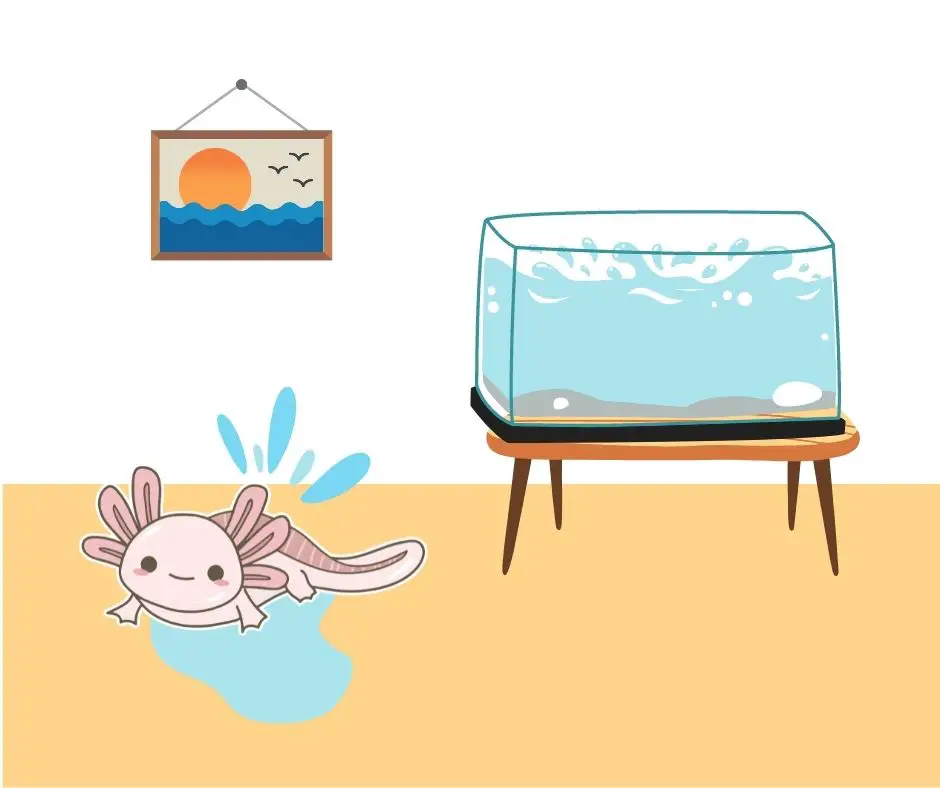
Floating
Although axolotls are bottom dwellers, it is quite normal for your axolotls to float. You can start to get worried if your axolotls are frequently floating. Some of the reasons why axolotls can float are:
- Your axolotl is bloated
- Impaction
- Bad water quality.
A good way to treat your axolotl floating is to determine how long they are doing it and if it is frequently.
You can then try to scare your axolotl to see if they swim to the tank’s bottom. Your axolotl will swim back to the bottom if it is floating due to air bubbles.
However, axolotl may not swim to the tank’s bottom if the water condition is poor or they have health problems.
You can then test the water quality in the tank and change the water if the water quality is poor.
On the other hand, you need to stop feeding your axolotl for a few days or try to fridge them if this health problem happens because of impaction.
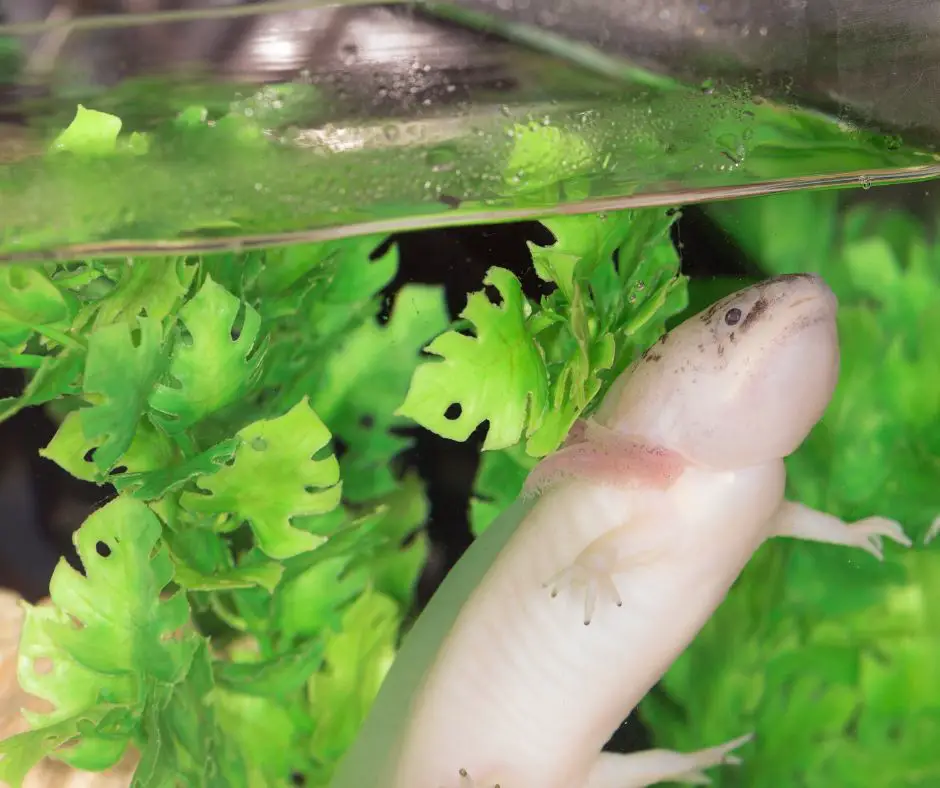
Throwing Up
Axolotls can throw up due to several reasons, and they are
- Ammonia poisoning
- Too much food
- Wrong water temperature
- Impaction
- Poor food quality
Before you can treat this problem, you will first need to determine the cause. After that, you can then treat the problem accordingly. You may even require the help of a vet to treat some problems.
Not Eating
Like any pets, axolotls need to eat to stay healthy and active. A common sign that an axolotl is not healthy or happy is if it stops eating.
There are several reasons that an axolotl can stop eating, and it ranges from a simple to a complex cause.
Some of them are:
- Feeding axolotls with poor quality food
- Your axolotl is impacted or constipated
- Poor water quality
- Putting your axolotl in a new home
- You are overfeeding your axolotls
- Aggressive tank mates
- Egg or water retention
- Illness, etc.
Some of the things that you can do if your axolotl is not eating are:
- Allow your axolotl to acclimatize to a new environment.
- Check the water condition in your axolotl’s tank.
- Feed your axolotl with the right pellet suitable for their age and size.
- Feed your axolotl with smaller food to help ensure they can swallow it faster.
- Try to feed your axolotl with its favorite food
- Be on the lookout for your axolotl’s tank mates
- Consult with your vet for the best treatment.
Not Growing
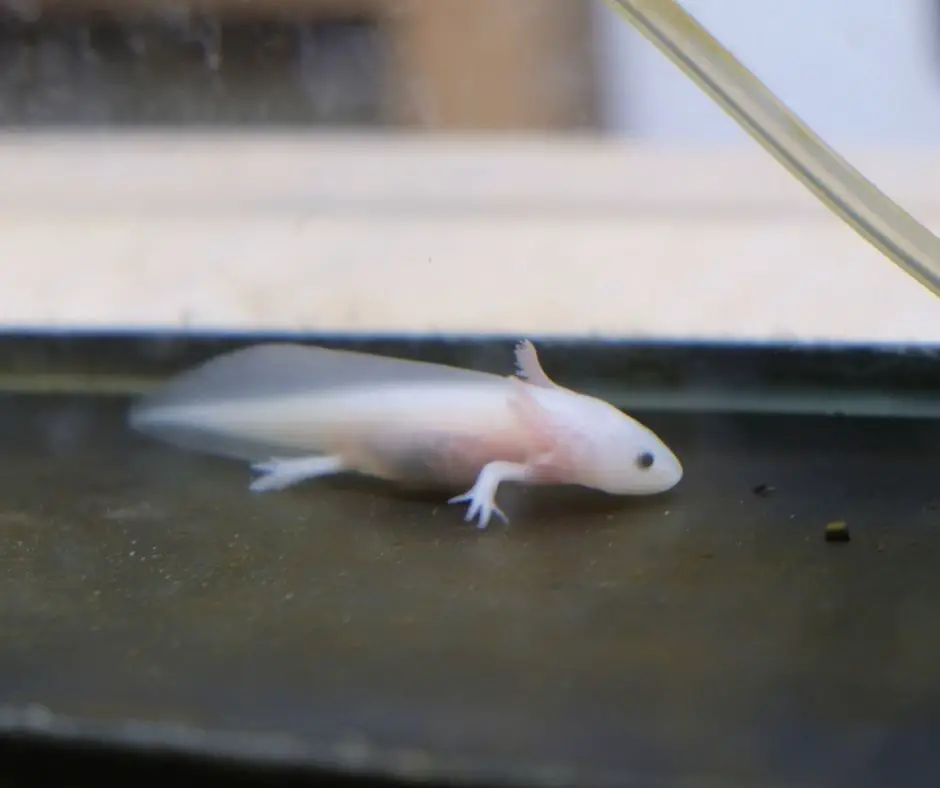
Axolotls can grow up to 7-12 inches long from the tip of their nose to their tail end. Generally, they usually grow to their full size at about 18-24 months after hatching.
However, axolotls can experience stunted growth or even stop growing.
This usually happens due to several reasons, such as
- Lack of quality diet
- Lack of appetite
- Poor environment
- Genetics
- Illness
Some of the ways that you can help stimulate growth in your axolotls are
- Change their diet.
- Ensure they are living in an ideal environment.
- Consult with your vet.
Do Axolotls Require High Maintenance?
Generally, axolotls are not that expensive to buy. You can easily buy common axolotl morph at a low price of about $20-$80. However, rare axolotl morphs can cost you more than $100.
Apart from buying an axolotl, you will need to consider other likely costs such as an enclosure, food, water filter, accessories, vet visits, and so on.
These costs can make keeping axolotl as a pet quite expensive, but it is usually for the first year.
Setting up an enclosure with a water filter, substrate, pump, and other accessories can cost around $200-$400. You will also need to consider recurring costs like food, vet check-up, substrate, etc.
The cost of axolotl food is around $10-$20 monthly or between $120-$240 annually.
Conclusion
Axolotls are adorable creatures which are why they are getting popular among fish and amphibian keepers. Furthermore, they are not that demanding when it comes to their care.
However, they are not suitable for people looking for a pet that they can handle.
Caring for them can also be difficult for first-time owners. Keeping this species can become easier if you know about aquarium cycling and water quality.
However, the reward of keeping them is amazing, and you will not look back once you get this adorable pet.
